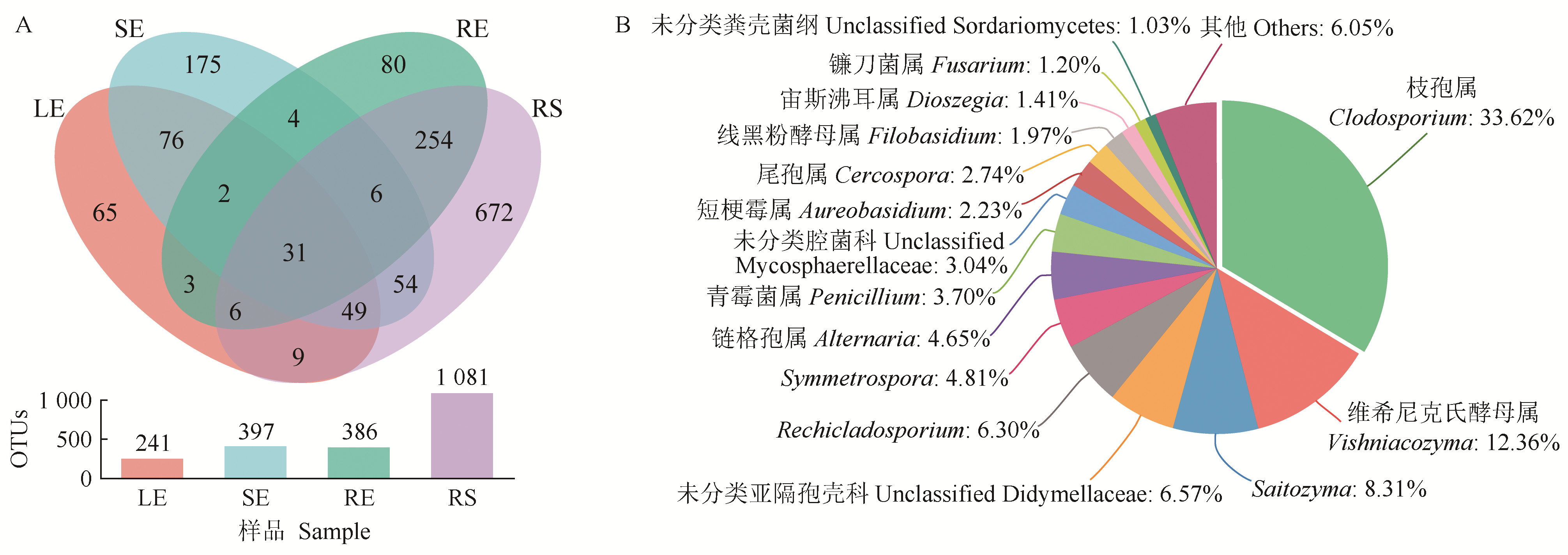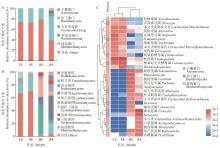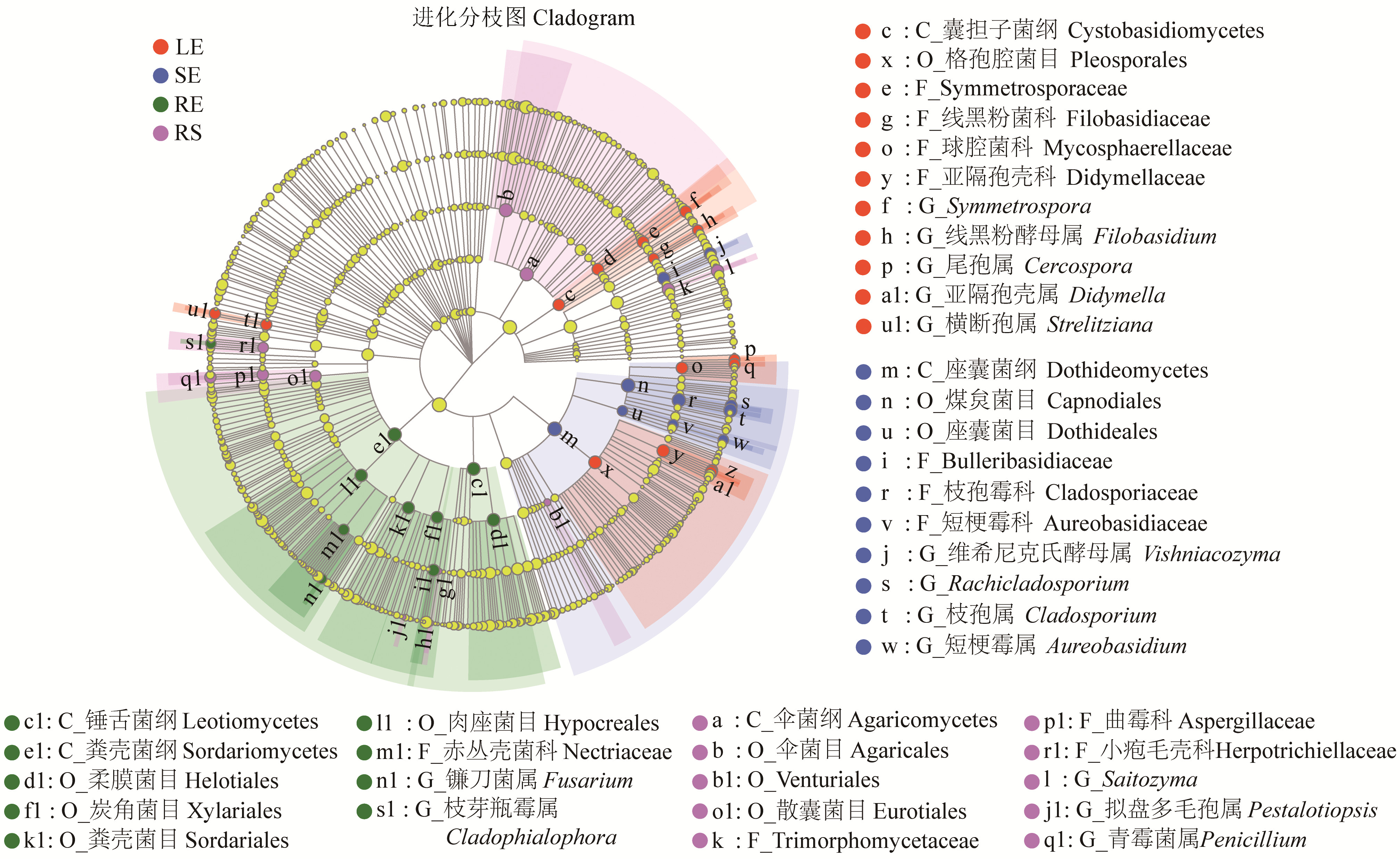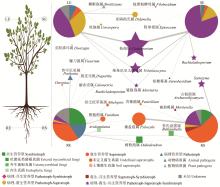

Scientia Silvae Sinicae ›› 2022, Vol. 58 ›› Issue (5): 102-112.doi: 10.11707/j.1001-7488.20220511
Previous Articles Next Articles
Bin Li1,Hongxiang Shi2,Lanlan Liu2,Pu Yang1,Xin Zhang1,Hang Chen1,Ying Feng1,Xiaoming Chen1,*
Received:2021-05-27
Online:2022-05-25
Published:2022-08-19
Contact:
Xiaoming Chen
CLC Number:
Bin Li,Hongxiang Shi,Lanlan Liu,Pu Yang,Xin Zhang,Hang Chen,Ying Feng,Xiaoming Chen. Characteristics of Community Structure and Functional Group of Fungi in Leaf, Stem, Root and Rhizosphere Soil of Ligustrum lucidum[J]. Scientia Silvae Sinicae, 2022, 58(5): 102-112.
Table 1
Sequencing information and Alpha diversity index in different samples"
| 样品 Sample | 原始序列数 Raw sequences | 有效序列数 Valid sequences | 丰富度指数Richness index | 多样性指数Diversity index | 覆盖度 Coverage (%) | |||
| Chao1 | Ace | Shannon | Simpson | |||||
| LE | 60 659±5 372 | 60 527±5381 | 142.36±28.11 a | 138.19±24.56 a | 3.08±0.22 a | 0.096±0.02 a | 99.98±0.01 | |
| SE | 61 233±4 283 | 60 331±3 849 | 283.55±57.84 b | 281.89±55.43 b | 3.00±0.48 a | 0.118±0.02 a | 99.93 ±0.04 | |
| RE | 61 562±9 633 | 61 330±9 499 | 191.91±50.66 a | 193.38±53.24 a | 2.86±0.07 a | 0.148±0.06 a | 99.97± 0.02 | |
| RS | 69 180±3 097 | 67 764±2 814 | 900.90±12.30 c | 903.80±16.31 c | 3.89±0.13 b | 0.096±0.01 a | 99.74 ±0.01 | |
| 合计Total | 757 906 | 749 855 | — | — | — | — | — | |

Fig.1
OTUs Venn diagram (A) and common genera (B) of fungal communities of four samples Different colors in the Fig.B represented different species, and its area represented the percentage of a given species in the total number of common species. The LE, SE, RE and RS represented leaf endosphere, stem endosphere, root endosphere and rhizosphere soil respectively, the same below."


Fig.2
The relative abundance of fungi in four samples at phylum (A), class (B) and genus (C) level In figure A and figure B, the "others" represented the sum of fungal taxa with relative abundance of less than 1%. In figure C, the colors represented the logarithms of relative abundance of fungi."

Table 2
Analysis of similarities (LE vs SE vs RE vs RS) of fungal communities between the samples"
| 样品Sample | R | P |
| LE vs SE vs RE vs RS | 0.898 1 | 0.001* |
| LE vs SE vs RE | 0.728 4 | 0.001* |
| LE vs SE vs RS | 0.950 6 | 0.001* |
| SE vs RE vs RS | 1 | 0.001* |
| LE vs SE | 0.777 8 | 0.098 |
| LE vs RE | 1 | 0.098 |
| LE vs RS | 1 | 0.098 |
| SE vs RE | 1 | 0.098 |
| SE vs RS | 1 | 0.098 |
| RE vs RS | 0.814 8 | 0.098 |

Fig.5
LEfSe analysis of differential species in different samples The red, blue, green and purple nodes in the figure represented fungal taxa that were significantly enriched in LE, SE, RE and RS respectively, and significantly influenced the differences between groups at the same time. The yellow nodes represented fungal taxa that have no significant differences among different groups, or that had no significant effect on the differences between groups. The C, O, F and G represented class, order, family and genus, respectively."


Fig.6
Functional group composition and network of fungi in leaf, stem, root and rhizosphere soil Different colors represent different fungal trophic types or Guilds, the pie diagram area indicates the relative abundance of different trophic types in each sample, the size of nodes indicates the absolute abundance of a genus in all samples, the thickness of links indicates the relative abundance of the genera."

| 曹红雨, 高广磊, 丁国栋, 等. 呼伦贝尔沙区4种生境土壤真菌群落结构和多样性. 林业科学, 2019, 55 (8): 118- 127. | |
| Cao H Y , Gao G L , Ding G D , et al. Community structure and diversity of soil fungi in four habitats in Hulun Buir sandy land. Scientia Silvae Sinicae, 2019, 55 (8): 118- 127. | |
| 陈安徽, 陈宏伟, 邵颖, 等. 女贞内生真菌清除自由基活性成分的分离纯化. 食品科学, 2014, 35 (9): 101- 105. | |
| Chen A H , Chen H W , Shao Y , et al. Separation and purification of free radical scavenging bioactive components from endophytic fungi in Ligustrum lucidum. Food Science, 2014, 35 (9): 101- 105. | |
| 陈晓鸣. 白蜡虫自然种群生态学. 北京: 科学出版社, 2011. | |
| Chen X M . Natural population ecology of Ericerus pela. Beijing: Science Press, 2011. | |
| 程敏, 胡正海. 女贞子的生物学和化学成分研究进展. 中草药, 2010, 41 (7): 1219- 1221. | |
| Cheng M , Hu Z H . Advances in research on biological and chemical constituents of Ligustrum lucidum. Chinese Traditional and Herbal Drugs, 2010, 41 (7): 1219- 1221. | |
| 何铮. 镉胁迫下丛枝菌根真菌对大叶女贞生长及镉耐受性的影响. 西部林业科学, 2020, 49 (1): 87- 91. | |
| He Z . Effects of arbuscular mycorrhizal fungi on growth and cadmium tolerance of Ligustrum compactum under cadmium stress. Journal of West China Forestry Science, 2020, 49 (1): 87- 91. | |
| 刘美红, 李帅岚, 张莲, 等. 女贞属植物的化学成分和药理活性研究进展. 中草药, 2020, 51 (12): 226- 237. | |
| Liu M H , Li S L , Zhang L , et al. Review on research progress of chemical constituents and pharmacological activities of Ligustrum. Chinese Traditional and Herbal Drugs, 2020, 51 (12): 226- 237. | |
| 王颜波, 张伟溪, 丁昌俊, 等. 不同生态环境下银中杨内生菌群落结构及生态位变异. 林业科学, 2020, 56 (2): 48- 60. | |
| Wang Y B , Zhang W X , Ding C J , et al. Community structure and niche differentiation of endophytic microbiome in Populus alba×P.berolinensis under different ecological environment.. Scientia Silvae Sinicae, 2020, 56 (2): 48- 60. | |
| 王志伟, 陈永敢, 王庆璨, 等. 中国植物内生微生物研究的发展和展望. 微生物学通报, 2014, 41 (3): 482- 496. | |
| Wang Z W , Chen Y G , Wang Q C , et al. Progresses and perspectives of studies on plant endophytic microbes in China. Microbiology China, 2014, 41 (3): 482- 496. | |
| 谢宪, 梁军, 朱彦鹏, 等. 赤松纯林不同松枯梢病病级针叶的内生真菌多样性及群落结构. 林业科学, 2020, 56 (9): 51- 57. | |
| Xie X , Liang J , Zhu Y P , et al. Diversity and community structure of endophytic fungi in the pure forest of Pinus densiflora infected by different incidences of Sphaeropsis sapinea. Scientia Silvae Sinicae, 2020, 56 (9): 51- 57. | |
| 袁志林, 潘雪玉, 靳微. 林木共生菌系统及其作用机制--以杨树为例. 生态学报, 2019, 39 (1): 381- 397. | |
| Yuan Z L , Pan X Y , Jin W . Tree-associated symbiotic microbes and underlying mechanisms of ecological interactions: a case study of poplar. Acta Ecologica Sinica, 2019, 39 (1): 381- 397. | |
| 袁志林, 章初龙, 林福呈. 植物与内生真菌互作的生理与分子机制研究进展. 生态学报, 2008, 28 (9): 4430- 4439. | |
| Yuan Z L , Zhang C L , Lin F C . Recent advances on physiological and molecular basis of fungal endophyte-plant interactions. Acta Ecologica Sinica, 2008, 28 (9): 4430- 4439. | |
| 张爱娣, 郑仰雄, 黄东兵. 丛枝菌根真菌对大叶女贞耐盐性的影响. 江苏农业科学, 2018, 46 (19): 129- 133. | |
| Zhang A D , Zheng Y X , Huang D B . Effects of arbuscular mycorrhizal fungi on salt tolerance of Ligustrum compactum. Jiangsu Agricultural Sciences, 2018, 46 (19): 129- 133. | |
|
Adams R I , Miletto M , Taylor J W , et al. Dispersal in microbes: fungi in indoor air are dominated by outdoor air and show dispersal limitation at short distances. The ISME Journal, 2013, 7 (7): 1262- 1273.
doi: 10.1038/ismej.2013.28 |
|
|
Ariantari N P , Ancheeva E , Frank M , et al. Didymellanosine, a new decahydrofluorene analogue, and ascolactone C from Didymella sp.IEA-3B. 1, an endophyte of Terminalia catappa. RSC Advances, 2020, 10 (12): 7232- 7240.
doi: 10.1039/C9RA10685E |
|
| Bollmann-Giolai A , Giolai M , Heavens D , et al. A low-costpipeline for soil microbiome profiling. MicrobiologyOpen, 2020, 9, e1133. | |
|
Chen P , Zhao M , Tang F , et al. The effect of plant compartments on the Broussonetia papyrifera-associated fungal and bacterial communities. Applied Microbiology and Biotechnology, 2020, 104 (8): 3627- 3641.
doi: 10.1007/s00253-020-10466-6 |
|
|
Chen S , Zhou Y , Chen Y , et al. fastp: an ultra-fast all-in-one FASTQ preprocessor. Bioinformatics, 2018, 34 (17): i884- i890.
doi: 10.1093/bioinformatics/bty560 |
|
|
Cregger M A , Veach A M , Yang Z K , et al. The Populus holobiont: dissecting the effects of plant niches and genotype on the microbiome. Microbiome, 2018, 6 (1): 31.
doi: 10.1186/s40168-018-0413-8 |
|
| Coleman-Derr D , Desgarennes D , Fonseca-Garcia C , et al. Plant compartment and biogeography affect microbiome composition in cultivated and native Agave species. New Phytologist, 2015, 209 (2): 798- 811. | |
|
Edgar R C . UPARSE: highly accurate OTU sequences from microbial amplicon reads. Nature Methods, 2013, 10 (10): 996- 998.
doi: 10.1038/nmeth.2604 |
|
|
Fitzpatrick C R , Salas-Gonzalez I , Conway J M , et al. The plant microbiome: from ecology to reductionism and beyond. Annual Review of Microbiology, 2020, 74, 81- 100.
doi: 10.1146/annurev-micro-022620-014327 |
|
| Fonseca-García C , Coleman-Derr D , Garrido E , et al. The Cacti microbiome: interplay between habitat-filtering and host-specificity. Frontiers in Microbiology, 2016, 7, 150. | |
|
Hassani M A , Ozkurt E , Seybold H , et al. Interactions and coadaptation in plant metaorganisms. Annual Review of Phytopathology, 2019, 57, 483- 503.
doi: 10.1146/annurev-phyto-082718-100008 |
|
|
Hollister E B , Lesniewski R A , Oakley B B , et al. Introducing mothur: open-source, platformindependent, community-supported software for describing and comparing microbial communities. Applied and Environmental Microbiology, 2009, 75 (23): 7537- 7541.
doi: 10.1128/AEM.01541-09 |
|
|
Kuzyakov Y , Razavi B S . Rhizosphere size and shape: temporal dynamics and spatial stationarity. Soil Biology and Biochemistry, 2019, 135, 343- 360.
doi: 10.1016/j.soilbio.2019.05.011 |
|
|
Lemanceau P , Blouin M , Muller D , et al. Let the core microbiota be functional. Trends in Plant Science, 2017, 22 (7): 583- 595.
doi: 10.1016/j.tplants.2017.04.008 |
|
|
Li S J , Zhang X , Wang X H , et al. Novel natural compounds from endophytic fungi with anticancer activity. European Journal of Medicinal Chemistry, 2018, 156, 316- 343.
doi: 10.1016/j.ejmech.2018.07.015 |
|
|
Liu Y X , Qin Y , Chen T , et al. A practical guide to amplicon and metagenomic analysis of microbiome data. Protein Cell, 2021, 12 (5): 315- 330.
doi: 10.1007/s13238-020-00724-8 |
|
|
Martin F M , Uroz S , Barker D G . Ancestral alliances: plant mutualistic symbioses with fungi and bacteria. Science, 2017, 356 (6340): eaad4501.
doi: 10.1126/science.aad4501 |
|
|
Mago DčT , Salzberg SL . FLASH: fast length adjustment of short reads to improve genome assemblies. Bioinformatics, 2011, 27 (21): 2957- 2963.
doi: 10.1093/bioinformatics/btr507 |
|
| Mousa W K , Schwan A , Davidson J , et al. An endophytic fungus isolated from finger millet (Eleusine coracana) produces anti-fungal natural products. Frontiers in Microbiology, 2015, 6, 1157. | |
|
Nguyen N H , Song Z , Bates S T , et al. FUNGuild: An open annotation tool for parsing fungal community datasets by ecological guild. Fungal Ecology, 2016, 20, 241- 248.
doi: 10.1016/j.funeco.2015.06.006 |
|
|
Nilsson R H , Larsson K H , Taylor A F S , et al. The UNITE database for molecular identification of fungi: handling dark taxa and parallel taxonomic classifications. Nucleic Acids Research, 2019, 47 (D1): D259- D264.
doi: 10.1093/nar/gky1022 |
|
|
Philippot L , Raaijmakers J M , Lemanceau P , et al. Going back to the roots: the microbial ecology of the rhizosphere. Nature Reviews Microbiology, 2013, 11 (11): 789- 799.
doi: 10.1038/nrmicro3109 |
|
|
Porras-Alfaro A , Bayman P . Hidden fungi, emergent properties: endophytes and microbiomes. Annual Review of Phytopathology, 2011, 49, 291- 315.
doi: 10.1146/annurev-phyto-080508-081831 |
|
| Qin Y , Pan X Y , Yuan Z L . Seed endophytic microbiota in a coastal plant and phytobeneficial properties of the fungus Cladosporium cladosporioides. Fungal Ecology, 2016a, (24): 53- 60. | |
|
Rodriguez R J , Jr W J , Arnold A E , et al. Fungal endophytes: diversity and functional roles. New Phytologist, 2009, 182 (2): 314- 326.
doi: 10.1111/j.1469-8137.2009.02773.x |
|
|
Saleem M , Hu J , Jousset A . More than the sum of its parts: microbiome biodiversity as a driver of plant growth and soil health. Annual Review of Ecology, Evolution, and Systematics, 2019, 50 (1): 145- 168.
doi: 10.1146/annurev-ecolsys-110617-062605 |
|
|
Schulz B , Bommert A K , Dammann U , et al. The endophyte-host interaction: a balanced antagonism?. Mycological Research, 1999, 103 (10): 1275- 1283.
doi: 10.1017/S0953756299008540 |
|
|
Segata N , Izard J , Waldron L , et al. Metagenomic biomarker discovery and explanation. Genome Biology, 2011, 12 (6): R60.
doi: 10.1186/gb-2011-12-6-r60 |
|
|
Sun H , Gao S S , Li X M , et al. Chemical constituents of marine mangrove-derived endophytic fungus Alternaria tenuissima EN-192. Chinese Journal of Oceanology and Limnology, 2013, 31 (2): 464- 470.
doi: 10.1007/s00343-013-2106-2 |
|
|
Sun T , Wang X Q , Zhao Z L , et al. A lethal fungus infects the chinese white wax scale insect and causes dramatic changes in the host microbiota. Scientific Reports, 2018, 8, 5324.
doi: 10.1038/s41598-018-23671-1 |
|
|
Trivedi P , Leach J E , Tringe S G , et al. Plant-microbiome interactions: from community assembly to plant health. Nature Reviews Microbiology, 2020, 18, 607- 621.
doi: 10.1038/s41579-020-0412-1 |
|
|
Vandenkoornhuyse P , Quaiser A , Duhamel M , et al. The importance of the microbiome of the plant holobiont. New Phytologist, 2015, 206, 1196- 1206.
doi: 10.1111/nph.13312 |
|
|
Vorholt J A . Microbial life in the phyllosphere. Nature Reviews Microbiology, 2012, 10, 828- 840.
doi: 10.1038/nrmicro2910 |
|
|
Wang Q , Garrity G M , Tiedje J M , et al. Naive Bayesian classifier for rapid assignment of rRNA sequences into the new bacterial taxonomy. Applied and Environmental Microbiology, 2007, 73 (16): 5261- 5267.
doi: 10.1128/AEM.00062-07 |
|
| Wang H X , Shi H , Wang Y H . Effects of weather, time, and pollution level on the amount of particulate matter deposited on leaves of Ligustrum lucidum. The Scientific World Journal, 2015, 2015, 935942. | |
| Yan L , Zhu J , Zhao X , et al. Beneficial effects of endophytic fungi colonization on plants. Applied Microbiology and Biotechnology, 2019, 103, 3327- 3340. | |
|
Zarraonaindia I , Owens S M , Weisenhorn P , et al. The soil microbiome influences grapevine-associated microbiota. mBio, 2015, 6 (2): e02527-14.
doi: 10.1128/mBio.02527-14 |
|
|
Zhou J , Zhang Z , Zhang Y , et al. Effects of lead stress on the growth, physiology, and cellular structure of privet seedlings. PLoS One, 2018, 13 (3): e0191139.
doi: 10.1371/journal.pone.0191139 |
|
|
Zhou L L , Li X P , Kotta-Loizou I , et al. A mycovirus modulates the endophytic and pathogenic traits of a plant associated fungus. The ISME Journal, 2021, 15, 1893- 1906.
doi: 10.1038/s41396-021-00892-3 |
| [1] | Wang Lixiang, Cui Shupeng, Kong Lulu, Wang Xuan, Yang Zongji, Ren Lili, Luo Youqing. Inhibitory Effects of Endophytic Fungi in Host Tree on the Symbiotic Fungi of Sirex nitobei (Hymenoptera: Siricidae) [J]. Scientia Silvae Sinicae, 2022, 58(5): 113-120. |
| [2] | Feiran Jia,Zhongfu Zhou,Wenxia Zhao,Huiquan Sun,Yanxia Yao. Diversity of Gut Microorganisms in Natural Population of Agrilus mali (Coleoptera: Buprestidae) [J]. Scientia Silvae Sinicae, 2022, 58(3): 86-96. |
| [3] | Wei Cong,Jingjing Yu,Haimang Yu,Yi Ding,Yuguang Zhang. Diversity and Community Assembly of Forest Soil Microorganisms in Different Climatic Zones [J]. Scientia Silvae Sinicae, 2022, 58(2): 70-79. |
| [4] | Pengyu Zhao,Xue Bai,Pingmei Yan,Xiaodong Zhao,Xiaoying Wu,Baofeng Chai. Responses of Soil Bacterial Community Structure and Phenotype to Soil Heterogeneity in Larix principis-rupprechtii Forest [J]. Scientia Silvae Sinicae, 2021, 57(7): 101-110. |
| [5] | Jingru Liu,Yi Cao,Han Li,Li Zhang,Chengming You,Zhenfeng Xu,Bo Tan. Diversity of Soil Arthropods during Cinnamomum camphora and Pinus massoniana Litter Decomposition in Low Mountainous and Hilly Areas of Sichuan [J]. Scientia Silvae Sinicae, 2021, 57(11): 119-133. |
| [6] | Rongrong Pang,Jieying Peng,Yan Yan. Factors Influencing Aboveground Biomass in the Secondary Forest of Quercus aliena var. acutiserrata in Taibai Mountain [J]. Scientia Silvae Sinicae, 2021, 57(10): 157-165. |
| [7] | Xian Xie, Jun Liang, Yanpeng Zhu, Ruirui Hu, Yuan Cheng, Xingyao Zhang. Diversity and Community Structure of Endophytic Fungi in the Pure Forest of Pinus densiflora Infected by Different Incidences of Sphaeropsis sapinea [J]. Scientia Silvae Sinicae, 2020, 56(9): 51-57. |
| [8] | Xiaohong Zhao,Shanshan Chai,Manman Zhang,Yichang Fan,Yunfei Mao,Zhiquan Mao,Xiang Shen. Effects of Shell Powder on Microbial Diversity in Acidified Soil and Growth of Malus hupehensis var. mengshanensis Seedlings [J]. Scientia Silvae Sinicae, 2020, 56(9): 153-163. |
| [9] | Changlin Liu,Guoying Zhou,Bai Xiao,Jun Liu. Diversity of Endophytic Fungi in Heartwood and Sapwood of Dalbergia odorifera [J]. Scientia Silvae Sinicae, 2020, 56(4): 109-120. |
| [10] | Cao Hongyu, Gao Guanglei, Ding Guodong, Zhang Ying, Zhao Yuanyuan, Ren Yue, Chen Yuxuan, Guo Mishan. Community Structure and Diversity of Soil Fungi in Four Habitats in Hulun Buir Sandy Land [J]. Scientia Silvae Sinicae, 2019, 55(8): 118-127. |
| [11] | Chen Jinlei, Fang Xi, Gu Xiang, Li Leida, Liu Zhaodan, Wang Liufang, Zhang Shiji. Composition, Structure, and Floristic Characteristics of Two Forest Communities in the Central-Subtropical China [J]. Scientia Silvae Sinicae, 2019, 55(2): 159-172. |
| [12] | Mengmei Hu,Long Tian,Yanan Wu,Jinyu Yang,Xiaocui Lü,Xuanrui Huang. Influences of Thinning and Mixed Transformation of Larix principis-rupprechtii Plantations on the Community Structure of Soil Macro Faunal in Saihanba Area [J]. Scientia Silvae Sinicae, 2019, 55(11): 153-162. |
| [13] | Xiao Zhang,Shirong Liu,Yongtao Huang,Shenglei Fu. Changes on Community Structure and Diversity of Soil Bacterial Community during the Succession of Quercus wutaishanica [J]. Scientia Silvae Sinicae, 2019, 55(10): 193-202. |
| [14] | Li Nan, Jiang Ming, Tian Xue, Jin Guangze. Community Structure of Rotifers and Evaluation of Water Quality in Fujin National Wetland Park [J]. Scientia Silvae Sinicae, 2019, 55(1): 47-55. |
| [15] | Yang Anna, Lu Yunfeng, Zhang Junhong, Wu Jiasen, Xu Jinliang, Tong Zaikang. Changes in Soil Nutrients and Acidobacteria Community Structure in Cunninghamia lanceolata Plantations [J]. Scientia Silvae Sinicae, 2019, 55(1): 119-127. |
| Viewed | ||||||
|
Full text |
|
|||||
|
Abstract |
|
|||||